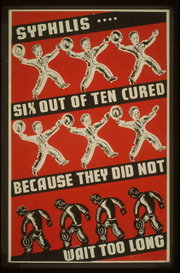Syphilis
Syphilis (historically called lues) is a sexually transmitted disease (STD) that is caused by a spirochaete bacterium, Treponema pallidum. Syphilis has many alternate names, such as: Miss Siff, the Pox, and has been given many national attributions, e.g. the "French disease" or the "English disease". more...
The route of transmission for syphilis is almost invariably by sexual contact; however, there are examples of direct contact infections (see yaws) and of congenital syphilis (transmission from mother to child in utero).
The signs and symptoms of syphilis are myriad; before the advent of serological testing, diagnosis was more difficult and the disease was dubbed the "Great-Imitator" because it was so often confused with other diseases.
Syphilis can be treated with penicillin or other antibiotics. Statistically, treatment with a course of pills is dramatically less effective than other treatments, because patients tend not to complete the course. The oldest, and still most effective, method is to inject benzathine penicillin into each buttock (procaine is added to make the pain bearable); the dose must be given half in each buttock because the amount given would be too painful if given in a single injection. An alternative treatment is to administer several tablets of azithromycin orally (which has a long duration of action) under observation. This latter course, however, may be falling on hard times, as strains of syphilis resistant to azithromycin have developed and may account for 10% of cases in some areas in 2004. Other treatments are less effective as the patient is required to take pills several times a day.
If not treated, syphilis can cause serious effects such as damage to the nervous system, heart, or brain. Untreated syphilis can be ultimately fatal.
History
There are two schools of thought on the origin of Syphilis: the Colombian and pre-Colombian theses. There are ongoing debates in anthropological and historical fields about the validity of either theory.
The pre-Colombian theory holds that syphilis symptoms are described by Hippocrates in Classical Greece in its venereal/tertiary form. Some passages in the Bible could refer to syphilis, especially Exodus 20:5 where the sins of the father are visited unto the third and fourth generation. There are other suspected syphilis findings for pre-contact Europe, including at a 13-14th century Augustinian friary in the northeastern English port of Kingston upon Hull. The anthropological evidence is contested by those who follow the Colombian theory.
The Colombian theory holds that syphilis was a new world disease brought back by Columbus. Although this evidence has been derided as "weak and circumstantial" the first well-recorded outbreak of what we know as syphilis occurred in Naples in 1494. There is some documentary evidence to link Columbus' crew to the outbreak. Supporters of the Colombian theory find syphilis lesions on pre-contact Native Americans. Again, all the anthropological evidence is heatedly discussed on both sides of the Colombian/pre-Columbian debate. (Baker, et al.)
Read more at Wikipedia.org




